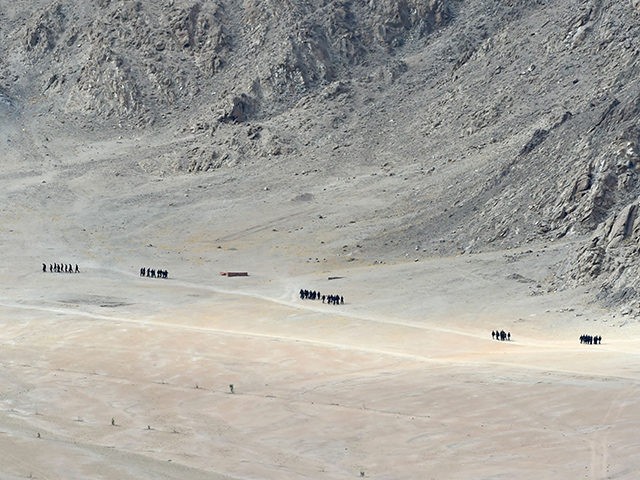Satellite images of the Ladakh region in the western Himalayas show Chinese construction activity picking up in the week following a deadly clash between Indian and Chinese forces along the disputed border.
According to India, this construction is taking place on its territory, contradicting Chinese claims that its forces have not violated the Line of Actual Control (LAC).
India frequently accuses China of pushing beyond the LAC and building fortifications to unilaterally move the border, a technique they refer to as the “walk-in strategy.” Indian military officials say the fight broke out because one of their patrols caught Chinese troops building observation posts on Indian territory. China denies these accusations and claims India provoked last week’s melee on the border by violating its territory.
Satellite imagery of the disputed Galwan Valley shows “a potential new camp under construction with walls or barricades” plus some “camouflaged tents or covered structures” built by Chinese troops on the Indian side of the LAC, Reuters reported Thursday. None of these structures were present during a satellite pass made one week earlier.
Indian troops have evidently created their own defensive structures over the past month, but have pulled back from a forward position near Chinese territory.
While neither the Chinese or Indian governments responded to requests for comment from Reuters, former Indian army chief Deepak Kapoor said there is clearly a “trust deficit so far as the Chinese are concerned.”
“So if they are telling us verbally they are ready to pull back, we will wait to see it on the ground. Until then the armed forces will be on alert,” said Kapoor.
The Times of India (TOI) noted the new Chinese construction sits in roughly the same spot as one of the smaller observation posts dismantled by an Indian patrol before the battle broke out on June 15. Despite talk of “de-escalation,” the Chinese People’s Liberation Army (PLA) appears to have reinforced positions across the region and occupied more Indian territory after last week’s border brawl. India is also moving more troops and weapons into the area, including artillery pieces.
“The PLA appears to have set up a large camp with gun positions at the site near the ‘Y-junction’ of the Shyok and Galwan rivers, which is slightly over a kilometer below PP-14, a reference point that marks the Indian side of the Line of Actual Control,” TOI reported.
Indian officials hopefully noted that most of China’s troop movements and fortification construction seems to have occurred between June 15 and June 22, the day when top Chinese and Indian military officers agreed to “gradual and verifiable disengagement,” so it might not be too late for the Chinese to pull back. The Indian military described the situation in Ladakh as “serious” but said there has been “no violence since June 15,” despite some positions where Indian and Chinese troops are only a few yards apart.
According to the military officials who spoke to TOI, China has “virtually opened up a new front in the Depsang Bulge area, a table-top plateau north of Galwan, with a huge deployment of troops and heavy weapons there to threaten the Burtse camp and Raki Nala areas of India.” Indian officers were confident they have enough troop strength in the Depsang Bulge to “prevent any misadventure.”
India’s Ministry of External Affairs said Thursday that China is showing “complete disregard of all mutually agreed norms” since the beginning of 2020 and blamed Beijing for “actions thus far which have led to an increase in tension in the region, and also to the violent face-off of 15th June with casualties.”
External Affairs Ministry spokesman Anurag Srivastava showed little of the guarded optimism displayed by the military sources who spoke with TOI, asserting that China’s latest troop movements and camp construction were clear violations of the de-escalation agreement reached earlier this week.
“The incidents and face-offs along the LAC need to be understood in the larger context of recent developments. That also helps to bring out the key issues that both sides are seeking to address. At the heart of the matter is that since early May, the Chinese side has been amassing a large contingent of troops and armaments along the LAC,” he said.
“All infrastructure built by the Indian side has always been on its own side of the LAC. The Indian side has never undertaken any actions across the LAC and has never attempted to unilaterally change the status quo. However, that has not been reciprocated by the Chinese side and that from time to time has led to face-offs,” Srivastava charged.
Al Jazeera News reported Wednesday that Indian fighter jets are now flying over the Himalayas in a “show of strength,” while “long lines of military trucks and artillery” have been seen passing through the main Indian regional military base at Leh. One retired Indian military officer said he had never “seen this kind of military movement before.”
The Chinese Foreign Ministry on Wednesday repeated accusations that India provoked the border crisis with its “reckless actions” and claimed India’s moves in the Ladakh region were “evil in nature and the consequences were severe.”

COMMENTS
Please let us know if you're having issues with commenting.